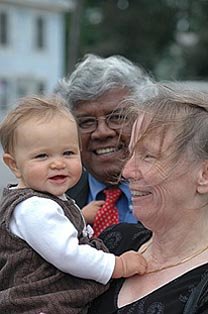Deshakalyan Chowdhury/Agence France-Presse — Getty Images
A Christian in her burned home in the Indian state of Orissa. Villagers blamed Hindu militants.

By SOMINI SENGUPTA
Published: October 12, 2008
BOREPANGA, India — The family of Solomon Digal was summoned by neighbors to what serves as a public square in front of the village tea shop.
Skip to next paragraph
Related
Times Topics: India

The New York Times
Borepanga has been rocked by weeks of religious violence.
They were ordered to get on their knees and bow before the portrait of a Hindu preacher. They were told to turn over their Bibles, hymnals and the two brightly colored calendar images of Christ that hung on their wall. Then, Mr. Digal, 45, a Christian since childhood, was forced to watch his Hindu neighbors set the items on fire.
“ ‘Embrace Hinduism, and your house will not be demolished,’ ” Mr. Digal recalled being told on that Wednesday afternoon in September. “ ‘Otherwise, you will be killed, or you will be thrown out of the village.’ ”
India, the world’s most populous democracy and officially a secular nation, is today haunted by a stark assault on one of its fundamental freedoms. Here in eastern Orissa State, riven by six weeks of religious clashes, Christian families like the Digals say they are being forced to abandon their faith in exchange for their safety.
The forced conversions come amid widening attacks on Christians here and in at least five other states across the country, as India prepares for national elections next spring.
The clash of faiths has cut a wide swath of panic and destruction through these once quiet hamlets fed by paddy fields and jackfruit trees. Here in Kandhamal, the district that has seen the greatest violence, more than 1000 people have been killed, 5,000 homes burned and over 230 churches destroyed, including the tin-roofed Baptist prayer hall where the Digals worshiped. Today it is a heap of rubble on an empty field, where cows blithely graze.
Across this ghastly terrain lie the singed remains of mud-and-thatch homes. Christian-owned businesses have been systematically attacked. Orange flags (orange is the sacred color of Hinduism) flutter triumphantly above the rooftops of houses and storefronts.
India is no stranger to religious violence between Christians, who make up about 2 percent of the population, and India’s Hindu-majority of 1.1 billion people. But this most recent spasm is the most intense in years.
It was set off, people here say, by the killing on Aug. 23 of a charismatic Hindu preacher known as Swami Laxmanananda Saraswati, who for 40 years had rallied the area’s people to choose Hinduism over Christianity.
The police have blamed Maoist guerrillas for the swami’s killing. But Hindu radicals continue to hold Christians responsible.
In recent weeks, they have plastered these villages with gruesome posters of the swami’s hacked corpse. “Who killed him?” the posters ask. “What is the solution?”
Behind the clashes are long-simmering tensions between equally impoverished groups: the Panas and Kandhas. Both original inhabitants of the land, the two groups for ages worshiped the same gods. Over the past several decades, the Panas for the most part became Christian, as Roman Catholic and Baptist missionaries arrived here more than 60 years ago, followed more recently by Pentecostals, who have proselytized more aggressively.
Meanwhile, the Kandhas, in part through the teachings of Swami Laxmanananda, embraced Hinduism. The men tied the sacred Hindu white thread around their torsos; their wives daubed their foreheads with bright red vermilion. Temples sprouted.
Hate has been fed by economic tensions as well, as the government has categorized each group differently and given them different privileges.
The Kandhas accused the Panas of cheating to obtain coveted quotas for government jobs. The Christian Panas, in turn, say their neighbors have become resentful as they have educated themselves and prospered.
Their grievances have erupted in sporadic clashes over the past 15 years, but they have exploded with a fury since the killing of Swami Laxmanananda.
Two nights after his death, a Hindu mob in the village of Nuagaon dragged a Catholic priest and a nun from their residence, tore off much of their clothing and paraded them through the streets.
1
The nun told the police that she had been raped by four men, a charge the police say was borne out by a medical examination. Yet no one was arrested in the case until five weeks later, after a storm of media coverage. Today, five men are under arrest in connection with inciting the riots. The police say they are trying to find the nun and bring her back here to identify her attackers.
Skip to next paragraph
Enlarge This Image

Parth Sanyal/Reuters
Christians driven from their homes by fears of forced conversions prayed at a refugee camp last week in Bhubaneshwar, India









No comments:
Post a Comment